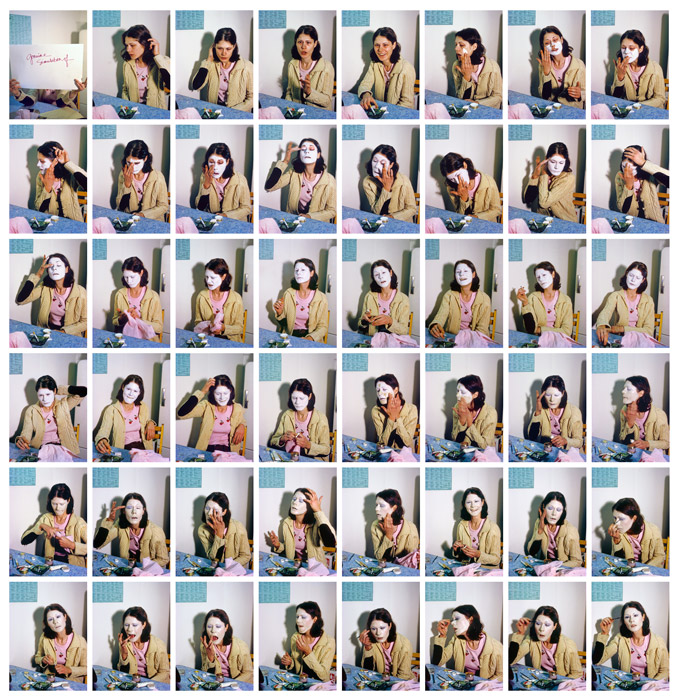Art Gallery of Ontario, Toronto
5 November, 2014 to 22 March, 2015
Par Sam Cotter
For over forty years, Suzy Lake has been engaging with the world of representation surrounding her, creating new images to open dialogues and complicate underlying ideologies. Introducing Suzy Lake, the first major museum retrospective of her work, organized by the Art Gallery of Ontario, looks to Lake’s performative engagement with the camera from the late 1960s to the present. The exhibition, heavily weighted in Lake’s major output of the 1970s, positions her in relation to the political and cultural associations of the cities in which she lived – Detroit, Montreal, and Toronto.1 Although the work included in the exhibition is never a literal commentary on specific events happening in these cities, this positioning creates a framework for understanding Lake’s methodology for producing images. Her work is never meant to be viewed in a vacuum; the images are always made in relation to a set of external cultural influences and the unspoken baggage contained in them. In On Stage (one of the earliest works in the exhibition) Lake struggles to address the representation of women in the culture surrounding her. The slideshow, made from 1972 to 1974, began with Lake photographing herself performing poses and attitudes from mainstream fashion publications, as she looked at the gaps between self-image and public perception. Shortly after, she revised the work to include text, autobiographical elements, and, eventually, images of herself in whiteface in an attempt to make it more legible to her contemporaries, who, by and large, were unable to read the subtleties of the codes that she was attempting to deconstruct. On Stage is among the first of her attempts to establish a personal visual language to address the dominant visual culture.
Around the same time, Lake produced several works more deeply exploring whiteface as a self-presentation device. In A Genuine Simulation Of… and Imitations of Myself #1, among others, she draws on mime traditions, using whiteface as a position zero, a form of self-erasure. Employing the photographic grid as a storytelling device, she applies whiteface makeup to herself – performing the act of becoming nothing, making herself a blank slate to be drawn upon. In both works, she proceeds to layer a mask of cultural normality overtop by applying conventional cosmetics.
As in On Stage, often-unquestioned ideas from cinema, fashion, and other cultural fantasy spaces are evoked. Lake transforms them, placing them firmly in the real world, weighing down on and acted out across her body. In exploring the discrepancies of these translations, she creates dissonance with the prevailing culture, implicating out-dated ideologies and expectations hidden beyond the frame. These (re)presentations of self, at once personal and removed, are hard to pin down. Lake’s work is never a one-liner; she opens a negotiation of power relationships through the subversion of the desire-oriented rhetoric of the images she draws on.
In works from the late 1970s, drama is heightened through more visceral performances for the camera. In her two ImPositions series, Lake stands bound in ropes at the end of a narrow corridor of padlocked doors; across the suites of photographs she alternates between resisting and resigning herself to confinement. And in the eighty-eight-part photo installation Are You Talking to Me? she performs another manifestation of anxiety, delivering a monologue to the camera inspired by Robert De Niro’s character’s soliloquy in Martin Scorsese’s Taxi Driver, displacing the precarious male bravado of the original character with a muted, but no less urgent, psychological turmoil.
Beyond the emotional performances that take place in front of the camera, Lake takes further control by adding intensity in post-production. She altered many of the negatives for images in both ImPositions and Are You Talking to Me? by stretching them over a candle flame, making it appear in the final print that the photographic frame must bend and contort to contain her body; the materials appear to be held as taut as the tethers binding her in ImPositions. In these works it appears that she is locked in a power struggle with the camera: she must alter herself or alter the device. She not only animates her body through performance, but also animates the photographic frame, imbuing it with the personal and subjective; she positions herself as a living force breathing life into the cold medium.
Throughout the retrospective, Lake offers an intentionally inharmonious synthesis of the cultures surrounding her. Much like a mime, who performs familiar actions but makes them strange by removing context, she assumes familiar postures without replicating the illusion that makes them desirable. By stripping away conventional artifice from image, her work becomes a site of encounter: between the body and the camera, the negative and the print, the photograph and the viewer. To introduce Suzy Lake is to open up an orchestrated place of negotiation, where the assumptions inherited from a collective visual culture become permeable, questioned, and undone.
Sam Cotter is a Toronto-based artist and writer; he employs photography, film, installation, and sculpture to focus on issues of visual representation and relationships between art and culture.

